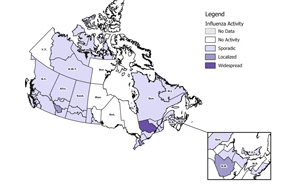 |
| Reported ILI Activity - Week 47 |
#13,709
Although reporting may be affected somewhat by the truncated Thanksgiving Holiday week, flu and ILI (Influenza-like Illness) indicators have begun to slowly climb in the United States - particularly in the deep south.
Unlike the last two winters - when H3N2 dominated North America's flu season - H1N1 is the most commonly reported subtype. While generally milder than H3N2, and better prevented by the vaccine, this strain tends to impact younger patients (both adults and children).Some excerpts from this week's FluView report:
2018-2019 Influenza Season Week 47 ending November 24, 2018
All data are preliminary and may change as more reports are received.
An overview of the CDC influenza surveillance system, including methodology and detailed descriptions of each data component, is available at http://www.cdc.gov/flu/weekly/overview.htm.
Synopsis:
Influenza activity in the United States increased slightly. The increase in the percentage of patient visits for ILI may be influenced in part by a reduction in routine healthcare visits during the Thanksgiving holidays, as has occurred in previous seasons.
Influenza A(H1N1)pdm09, influenza A(H3N2), and influenza B viruses continue to co-circulate, with influenza A(H1N1)pdm09 viruses reported most commonly by public health laboratories since September 30, 2018. Below is a summary of the key influenza indicators for the week ending November 24, 2018:
(Continue . . . )
- Viral Surveillance: Influenza A viruses have predominated in the United States since the beginning of July. The percentage of respiratory specimens testing positive for influenza in clinical laboratories was low.
- Virus Characterization: The majority of influenza viruses characterized antigenically and genetically are similar to the cell-grown reference viruses representing the 2018–2019 Northern Hemisphere influenza vaccine viruses.
- Antiviral Resistance: All viruses tested since late May show susceptibility to the antiviral drugs oseltamivir, zanamivir, and peramivir.
- Influenza-like Illness Surveillance: The proportion of outpatient visits for influenza-like illness (ILI) increased to 2.3%, which is above the national baseline of 2.2%. Five of 10 regions reported ILI at or above their region-specific baseline level.
- ILI State Activity Indictor Map: Two states experienced high ILI activity; three states experienced moderate ILI activity; New York City, the District of Columbia, Puerto Rico and eight states experienced low ILI activity; and 37 states experienced minimal ILI activity.
- Geographic Spread of Influenza: The geographic spread of influenza in five states was reported as regional; 16 states reported local activity; the District of Columbia, Puerto Rico, the U.S. Virgin Islands and 28 states reported sporadic activity; and Guam and one state reported no influenza activity.
- Pneumonia and Influenza Mortality: The proportion of deaths attributed to pneumonia and influenza (P&I) was below the system-specific epidemic threshold in the National Center for Health Statistics (NCHS) Mortality Surveillance System.
- Influenza-associated Pediatric Deaths: Two influenza-associated pediatric deaths were reported to CDC for week 47.
While the U.S. is just starting to see an uptick in flu activity, two weeks ago Canada announced an early start to their flu season (see Canada FluWatch Week 45: Early Flu Affecting Younger Age Groups).
That upward trend continues for a third week in a row, with children under the age of 5 being particularly hard hit.
FluWatch report: November 18, 2018 to November 24, 2018 (Week 47)
Download the alternative format
(PDF format, 909 KB, 9 pages)
Organization: Public Health Agency of Canada
Date published: 2018-11-30
Overall Summary
- Influenza activity continued to increase in week 47.
- Influenza A is the most common influenza virus circulating in Canada, and the majority of these viruses are A(H1N1)pdm09.
- The number of influenza-associated hospitalizations continued to increase in week 47. In particular, the number of pediatric hospitalizations is significantly higher than in recent years.
Severe Outcomes Influenza Surveillance
Provincial/Territorial Influenza Hospitalizations and Deaths
To date this season, more than 471 influenza-associated hospitalizations have been reported by participating provinces and territoriesFootnote 1.Hospitalizations (Table 2):
99% (471) were associated with influenza AThe highest estimated rates of hospitalization are among children under 5 years of age.
Intensive Care Unit (ICU) cases and deaths:
To date this season 49 ICU admissions and nine deaths have been reported.
While there are hopes we can avoid a repeat of last year's very severe flu season (see CDC: The Estimated Burden Of Last Year's Flu Season), H1N1 is far from benign, and can inflict a lot of damage.
The good news is the flu vaccine is generally more effective against H1N1 than it was last year against H3N2, and there is still time to get the vaccine if you haven't.But whether you get the flu shot or not - particularly given the number of non-influenza viruses out there - now is also the time to start consistently practicing good flu hygiene (covering coughs, washing hands, staying home if you are sick, etc.).

